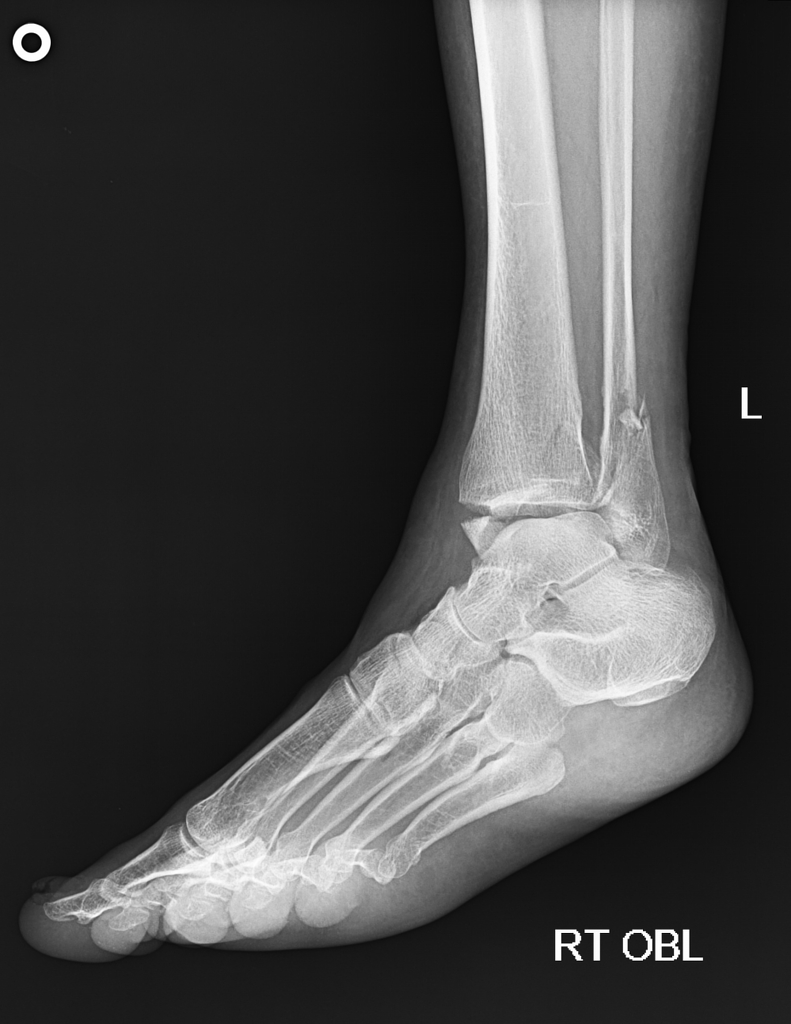Open Up That Fracture
Author: Alex Tomesch, MD, CAQ-SM
Peer-Reviewer: Dacia Ticas, MD
Final Editor: Mark Hopkins, MD, CAQ-SM; Will Denq, MD, CAQ-SM
A 65 year old farmer presents to the ED after his ankle was run over by a piece of farm equipment in the field. His x-ray is shown below and he has an associated soft tissue injury overlying the area that is grossly contaminated with mud and manure.

Figure 1: Case courtesy of Dr Oyedepo Victor Olufemi, radiopaedia.org
What is the diagnosis?
Open, contaminated ankle fracture
What are the risk factors and mechanism of injury?
In this case, the farmer was run over by farm equipment. This environmental exposure puts him at risk of anaerobic microbes that need to be covered. See below for more. In general, higher energy mechanisms carry a higher risk of generating an open fracture.
What classification system should you use to categorize the injury?
It is important to evaluate the extent of the wound. The length of the wound, the extensiveness of soft tissue damage, the environment in which the injury is sustained, and vascular involvement are all factors to evaluate in the ED. The Gustilo-Anderson classification system guides management of these injuries, and can be found here [1, 2].
Which imaging modalities can be used?
Plain films are adequate to begin. Advanced imaging can be obtained for fracture management with input from the consulting orthopedic service.
What is the management in the ED?
For this patient, he has a Gustilo Type III open fracture. This requires a bedside washout, fracture stabilization, and immediate antibiotic coverage with cefazolin, metronidazole, and gentamicin.
In general, antibiotics should be given within 6 hours of injury, based on the above classification and the patient's environment they are coming from [2].
-
Type I/II fractures - cover for gram positive organisms (eg. cefazolin)
-
Type III fractures - additionally cover for gram-negative organisms (eg. ceftriaxone or gentamicin)
-
Presence of fecal or potential clostridial contamination such as a farm injury - cover for anaerobic coverage (eg. metronidazole). Consider treatment for cutaneous anthrax (typically with doxycycline or ciprofloxacin).
-
Irrigation with NS is sufficient within the ED prior to definitive management [3].
-
Pearl: Patients with comorbidities that affect wound healing have higher likelihood of infection (>80 years, nicotine use, diabetes, active malignancy, pulmonary insufficiency, and immunocompromised). No comorbidities - 4% risk of infection, 1-2 comorbidities 15%, 3+ comorbidities - 31% risk of infection [4].
-
Pearl: Don’t forget to update the patient’s Tetanus vaccine!
What is the definitive management of this injury? When do you consult orthopedics?
Definitive management is formal operating room washout with orthopedic surgery
References
[1] Kim PH, Leopold SS. In brief: Gustilo-Anderson classification. Clin Orthop Relat Res. 2012;470:3270–3274.
[2] Hoff, William S. MD, FACS; Bonadies, John A. MD, FACS; Cachecho, Riad MD, FACS, FCCP; Dorlac, Warren C. MD, FACS East Practice Management Guidelines Work Group: Update to Practice Management Guidelines for Prophylactic Antibiotic Use in Open Fractures, The Journal of Trauma: Injury, Infection, and Critical Care: March 2011 - Volume 70 - Issue 3 - p 751-754 doi: 10.1097/TA.0b013e31820930e5
[3] FLOW Investigators, Bhandari M, Jeray KJ, Petrisor BA, Devereaux PJ, Heels-Ansdell D, Schemitsch EH, Anglen J, Della Rocca GJ, Jones C, Kreder H, Liew S, McKay P, Papp S, Sancheti P, Sprague S, Stone TB, Sun X, Tanner SL, Tornetta P 3rd, Tufescu T, Walter S, Guyatt GH. A Trial of Wound Irrigation in the Initial Management of Open Fracture Wounds. N Engl J Med. 2015 Dec 31;373(27):2629-41. doi: 10.1056/NEJMoa1508502. Epub 2015 Oct 8. PMID: 26448371.
[4] Bowen TR, Widmaier JC. Host classification predicts infection after open fracture. Clin Orthop Relat Res. 2005 Apr;(433):205-11. doi: 10.1097/01.blo.0000150345.51508.74. PMID: 15805959.


